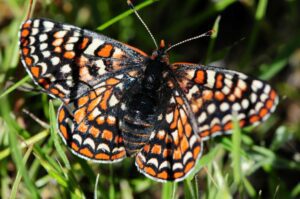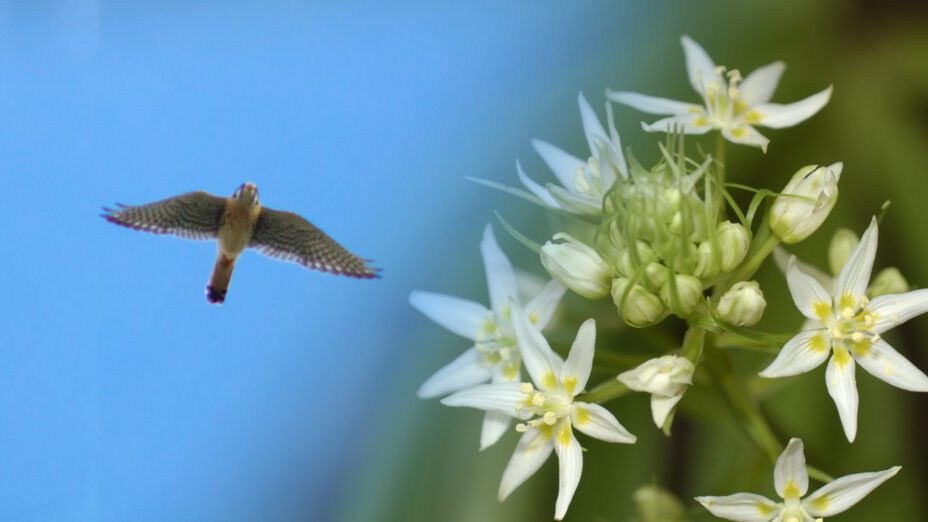
The Diablo Range is a biodiversity refuge for many rare, endemic, or unusual plants and animals. In honor of our 50th anniversary, we’ve compiled a list of some of them.
1. Mountain lion (Puma concolor)
According to the Mount Diablo interpretive association, no other animal presents a stronger case for the importance of wildlife corridors. Mountain lions utilize the corridors connecting Mount Diablo with Morgan Territory and with Black Diamond.
They’ve been known to range over 20 miles in one night. Mountain lion, while common in the greater Diablo Range, are currently not known to be present on Mount Diablo.
2. Mount Diablo buckwheat (Eriogonum truncatum)
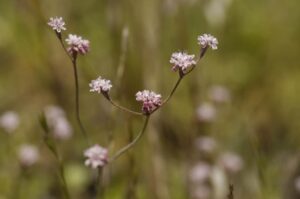
Mount Diablo buckwheat. Photo by Scott Hein
This small pink flower was thought to be extinct until 2005, when a population was discovered on land protected by Save Mount Diablo.
Since then, two other known populations have been discovered and multiple groups, including Save Mount Diablo, have been working to bring this wildflower back from the brink of extinction.
Mount Diablo buckwheat generally blooms from March through June and is more likely to grow in disturbed soils.
3. American badger (Taxidea taxus)
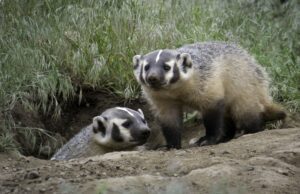
American badgers
For years, the elusive American badger has been a nearly mythical creature in the Mount Diablo area. As more land is preserved and poisoning and shooting have decreased, badgers have started showing up again.
Originally found throughout most of California, American badgers are more common in eastern Contra Costa County. Good habitats for them are grassy, open areas with dry, friable soils.
4. Burrowing owl (Athene cunicularia)
This small owl lives on a diet of insects and small mammals. In the Mount Diablo area, it commonly uses ground squirrel burrows. It can generally be found in open grasslands, farmland, and prairies.
According to the National Audubon Society, burrowing owls are likely to lose much of their range in the southern Diablo Range because of climate change in the coming decades.
5. San Benito poppy (Eschscholzia hypecoides)
This yellow poppy is mostly found in and adjacent to San Benito County within oak woodlands, grassland slopes, and chaparral. Much like the iconic California poppy, it grows in bunches and has wide-rounded petals.
6. Southern Coast Range newt (Taricha torosa torosa)
Southern Coast Range newt is a state species of special concern. There is one small population known to be present in the Diablo Range.
7. Peregrine falcon (Falco peregrinus)
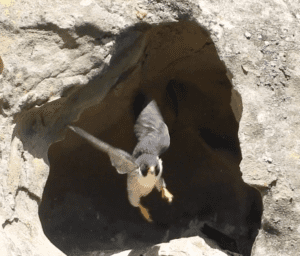
Peregrine falcon in flight. Photo by Wallace De Young
These raptors are the fastest animals on earth, able to dive at over 200 miles per hour to capture their prey, which mainly includes smaller birds.
Every year, parts of Castle Rock are closed to give nesting peregrine falcons peace and privacy. Too much human interference can make them unable to lay eggs and care for their young. Currently, there are only about 350 nesting pairs in the state of California.
8. Coast Range triteleia (Triteleia lugens)
Coast Range triteleia is endemic to California; it can be found near part of the western border of the Diablo Range as well as in the Coast Range north of San Francisco and in small part of the Sierra Nevada.
It can be identified by its six-petaled, yellow flowers that grow at the top of a long green stem in round formations.
9. Prairie falcon (Falco mexicanus)
Like peregrine falcons, prairie falcons are highly susceptible to the eggshell-thinning effects of DDT. Prairie falcon populations weren’t hit as hard as peregrines and merlins in the 20th century because their mammal-based diet exposed them to lower pesticide levels than their bird-eating relatives.
On and around Mount Diablo, prairie falcon populations are declining, so this species is one that we should watch and look for ways to help.
10. Alameda whipsnake (Masticophis lateralis euryxanthus)
Endemic to the Bay Area, Alameda whipsnakes can be found on properties that were protected by Save Mount Diablo. They can often be found in rock outcrops and chaparral habitats looking for lizards to eat.
11. Blunt-nosed leopard lizard (Gambelia sila)
This endangered lizard lives in the southern San Joaquin Valley and its surrounding foothills. It lives in grassland and desert habitats with insects consisting of 97 percent of its diet.
12. Contura Creek sandmat (Euphorbia ocellata ssp. ocellata)
This succulent is likely a host for the obscure sphinx moth (Erinnyis obscura).
13. Fairy fans (Clarkia breweri)
Fairy fans can be found in woodlands or chaparral habitats. This rare plant is endemic to California, where it is known from only seven counties in the central part of the state. Its distinctive pink flowers make it easy to spot when present.
14. Fire poppy (Papaver californicum)
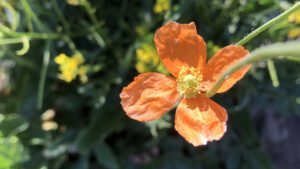
Fire poppy. Photo by Denise Castro
The seeds of this plant germinate in burned areas and can lie dormant for decades until the area experiences a fire. In 2021 and 2022, this rare flower was observed within the SCU fire complex.
The fire poppy looks similar to the wind poppy with a few key features such as the color at the base of the petals that distinguish the two.
15. Golden eardrops (Ehrendorferia chrysantha)
This flower lives in dry areas and thrives after wildfires. During our 2022 BioBlitz, Save Mount Diablo staff found large populations of these flowers in the SCU fire complex area.
16. Michael’s rein orchid (Piperia michaelii)
Endemic to California, this plant’s yellow-green flowers are fragrant in the evening.
17. California tiger salamander (Ambystoma californiense)
The California tiger salamander is the state’s second largest salamander, at up to eight inches long. It prefers to live in grasslands and oak savannas that contain vernal pools and stock ponds. It is federally and state listed as threatened.
Mount Diablo and its surrounding foothills contain many ponds that California tiger salamanders use for breeding. Several of these ponds are located on Save Mount Diablo preserved properties.
18. Mount Diablo birds-beak (Cordylanthus nidularius)
This rare plant is endemic to Mount Diablo. It grows in chaparral on serpentine soils; it is likely a host for the Leanira checkerspot butterfly (Chlosyne leanira).
19. Bay checkerspot butterfly (Euphydryas editha bayensis)
This medium-sized (2-inch wingspan) butterfly can be identified by the red, yellow, and white spots on its wings. Endemic to the Bay Area, it is found in habitats with shallow, serpentine soils. Because of habitat loss, this species is considered critically endangered.
20. Pinnacles buckwheat (Eriogonum nortinii)
This plant is mainly found within Pinnacles National Park and near the border separating Monterey and San Benito counties. It has a thin red stem with clusters of small pink flowers growing in round formations at the top.
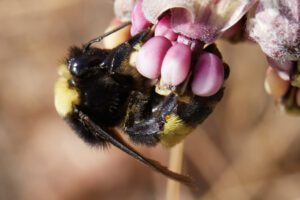
Crotch’s bumblebee. Photo by Ken-ichi Ueda
21. Crotch’s bumblebee (Bombus crotchii)
This bee can be found in grassland and chaparral areas, preferring a hotter environment. It eats milkweeds, sages, and lupines within its limited range. One was was observed during Save Mount Diablo’s 2022 BioBlitz.
22. San Benito thorn mint (Acanthomintha obovata)
This plant can be found in central California, particularly in San Benito County. It can be identified by its spiny leaves and white flowers.
23. Western monarch (Danaus plexippus)
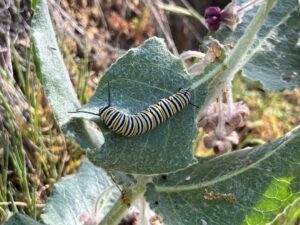
Monarch caterpillar on Mount Diablo. Photo by Sean Burke
This year, the western monarch was officially declared endangered by the IUCN. The larvae of this species only eat milkweed, relying on their abundance for survival. Surveys conducted this year found them on and near Mount Diablo, in seven different places.
24. Brewer’s western flax (Hesperolinon breweri)
This yellow flower can be found in the northern Diablo Range, and in the inner Coast Ranges northeast of San Francisco. It blooms from May to July and is distinguished by its bright flowers that bloom in bunches at the end of each stem.
25. California red-legged frog (Rana draytonii)
This threatened frog lives in slow-moving or standing water, such as deep ponds, streams, or marshes. In the 19th and 20th centuries, California red-legged populations were depleted because of habitat loss and overhunting. Today, they are still threatened by habitat loss from the threat of development.
California red-legged frogs are present on several Save Mount Diablo protected properties.
26. Mount Diablo globe lily (Calochortus pulchellus)
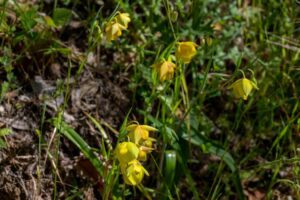
Mount Diablo globe lily. Photo by Scott Hein
Also known as the Mount Diablo fairy lantern, this flower is mainly found in the chaparral and woodland habitats on or around Mount Diablo. There are historic records in counties surrounding Contra Costa County.
This wildflower is considered so iconic that there’s even a trail named after it within Mount Diablo State Park.
27. Long-tailed weasel (Neogale frenata)
This is one of the smaller members of the weasel family in North America. It’s very secretive and often follows rodents like ground squirrels into their holes to prey on.
28. San Benito onion (Allium howellii var. sanbenitoense)
This southern Diablo Range endemic can be recognized by its bunches of lavender flowers that bloom in spring. It can grow up to two feet tall and has a long smooth stem.
29. Mount Diablo manzanita (Arctostaphylos auriculata)
This manzanita is an endangered woody shrub that can grow up to four and a half meters high. It becomes covered with pink flowers January to March and can be recognized by its shiny red branches, silvery leaves, and stems covered with hair.
30. California condor (Gymnopyps californianus)

Pinnacles condor 828 soaring through the skies. Photo by Tim Huntington
Last year, for the first time in over 100 years, a California condor paid the Mount Diablo vicinity a visit. California condors were brought back from the brink of extinction in the late 20th century; breeding programs have increased population numbers from 22 to nearly 500 condors.
31. Mount Diablo phacelia (Phacelia phacelioides)
This rare plant resides in the chaparral and woodland habitats of Mount Diablo and in other parts of the Diablo Range. Its stem grows up to 20 centimeters long and its flowers bloom white or lavender.
32. Mount Diablo sunflower (Helianthella castanea)
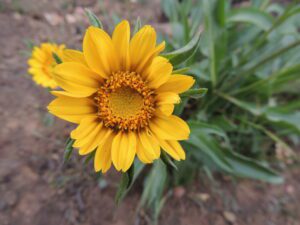
Mount Diablo sunflower. Photo by Sean Burke
This isn’t just any sunflower; it can only be found in the Bay Area and mostly lives on Mount Diablo! It’s a member of the daisy family, and its bright bright yellow flowers can be found peppering grassy or woody areas near streams in the spring.
33. Diablo sanicle (Sanicula saxatilis)
Also known as devil’s blacksnakeroot or rock sanicle, this plant known only from Mount Diablo and Mount Hamilton. It can be found in rocky areas and has small flowers during its blooming season.
34. San Joaquin kit fox (Vulpes macrotis mutica)

A San Joaquin kit fox with her pups at the Carrizo Plain National Monument. Photo by Scott Hein
San Joaquin kit foxes used to roam the foothills and valley floors of the San Joaquin Valley and adjacent Diablo Range foothills. However, in large part because of habitat loss, their numbers have been greatly reduced.
While scouting for our 2022 Bioblitz, our Land Programs Director observed several kit fox pups in part of the Diablo Range.
35. Tree anemone, bush anemone (Carpenteria californica)
This rare shrub is endemic to Fresno and Madera counties, growing in chaparral habitats. In May, June, and July, it blooms with four-petaled white flowers.
36. Santa Clara thorn mint (Acanthomintha lanceolota)
This plant can be found in coastal and inland mountain ranges east of San Jose and directly south of the Bay Area. It can be identified by its purple tipped thorns, white flowers, and unpleasant scent.
37. Sharsmith’s onion (Allium sharsmithiae)
Also known as the Mount Hamilton onion, this wild onion is endemic to the serpentine soils on and around Mount Hamilton, which is east of San Jose. Its flowers bloom a deep reddish purple, with a diameter of two centimeters.
38. American kestrel (Falco sparverius)

American kestrel release on Save Mount Diablo property. Photo by Mary Nagle
The American kestrel is the smallest falcon in North America, and its numbers have been declining in recent years. Locally, kestrels are especially abundant in Lime Ridge Open Space, Diablo Foothills Regional Park, and our Mangini Ranch Educational Preserve.
39. San Benito evening primrose (Camissonia benitensis)
A southern Diablo Range endemic, San Benito evening primrose is almost exclusively found growing on serpentine soils. It is likely the host for two species of moths and grows up to 7.9 inches tall.
40. Indian Valley bush-mallow (Malacothamnus aboriginum)
Indian Valley bush-mallow is endemic to California, where it is native to the inner central Coast Ranges to the west of the Central Valley. Its habitat includes the chaparral and woodland on rocky hillsides, where it is most plentiful after wildfire.
41. Hooked popcornflower (Plagiobothrys uncinatus)
Hooked popcornflower is endemic to the central Coast Ranges of California, where it is known mainly from the Santa Lucia Mountains and Gabilan Range in Monterey County.
42. Hospital canyon larkspur (Delphinum californicum interius)
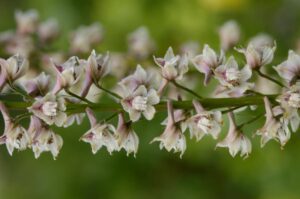
Hospital Canyon larkspur. Photo by Scott Hein
Hospital canyon larkspur is a rare native perennial herb that grows in central California, primarily in the San Francisco Bay region. It grows on Save Mount Diablo’s Mangini Ranch property.
43. San Benito spineflower (Chorizanthe douglasii)
San Benito spineflower is endemic to California.
44. Contra Costa manzanita (Arctostaphylos manzanita ssp. laevigata)
Contra Costa manzanita is a rare native shrub that grows in central California, primarily in the North Coast, the North Coast Range, and San Francisco Bay regions. It tends to grow in slopes and rocky places, at elevations from 0 to 4,900 feet.
45. Spring lessingia (Lessingia tenuis)
Spring lessingia is endemic to California, where it is known from the San Francisco Bay Area to Ventura County. It grows on the slopes of the California Coast Ranges in common local habitats such as chaparral.
46. Wand woolystar (Eriastrum virgatum)
Wand woolystar is endemic to California, where it is known in the coastline and coastal mountain ranges of Monterey and San Benito counties. It grows in chaparral and coastal and inland scrub habitat. It is an annual herb.
47. Lime Ridge navarretia (Navarretia gowenii)
Lime Ridge navarretia is a very rare plant that was discovered at Lime Ridge and has been found in only a few other places.
48. Foothill yellow-legged frog (Rana boylii)
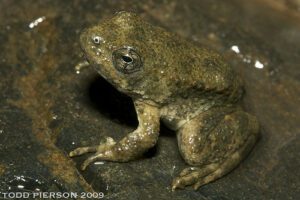
Foothill yellow-legged frog. Photo by Todd W Pierson / CC BY-NC-SA
This frog gets its name from the yellow shading on its belly and underside of the rear legs. It is no longer present in Contra Costa County. Foothill yellow-legged frogs in the Diablo Range are state listed as endangered and federally proposed for listing as threatened.
49. Most beautiful jewel flower (Streptanthus glandulosus ssp. glandulosus)
Most beautiful jewel flower is a rare native annual herb that grows in southern and central California, primarily in the San Francisco Bay, south Coast Range, and South Coast regions.
50. San Benito monardella (Monardella antonina ssp. benitensis)
San Benito monardella is a rare wildflower that is endemic to serpentine soils. It is mainly limited to the barren hills near the ghost town of New Idria in San Benito County.
Top photo by Stephen Joseph
